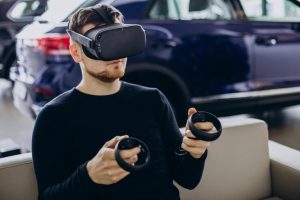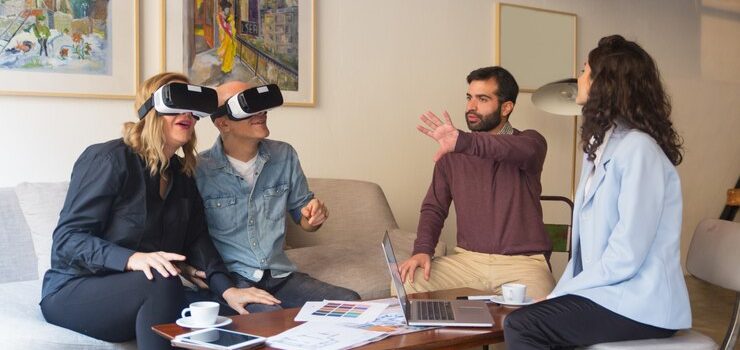
Introduction to Augmented Reality
Augmented Reality (AR) technology has emerged as a powerful tool in reshaping the digital and physical worlds, enhancing real-time experiences in ways that blend digital content with our surroundings. With recent advancements, AR has moved from experimental phases into practical applications across various sectors. Tech giants like OpenAI, Disney, Meta, and Apple are investing significantly to harness the full potential of AR, driving innovation in healthcare, retail, entertainment, and industrial sectors.
As we dive into the latest developments, we’ll explore how these advancements are transforming industries, from enabling precision in healthcare surgeries to offering immersive experiences in retail. Understanding these trends provides insight into the benefits and practical applications of AR, illustrating why the technology has garnered global attention.
Corporate Initiatives and Leadership Changes

OpenAI’s Strategic Move with Caitlin Kalinowski
OpenAI, a leader in artificial intelligence research, recently appointed Caitlin Kalinowski, formerly the head of AR glasses hardware at Meta, to lead its robotics and consumer hardware initiatives. Kalinowski’s expertise is expected to steer OpenAI toward more robust AR integration in consumer technology and robotics.
The impact of this hire highlights how tech companies value expertise in AR for expanding product offerings that cater to real-world applications. For OpenAI, this move signifies an alignment toward interactive AI-driven devices that will likely revolutionize consumer experiences. With Kalinowski’s experience, OpenAI’s future products may bridge the gap between physical and digital worlds, creating a seamless AR experience in daily life.
Disney’s New Technology Unit
Disney has taken a bold step by forming the Office of Technology Enablement, a business unit dedicated to coordinating advanced technologies like AR and artificial intelligence (AI) across its divisions. Disney has always been a pioneer in storytelling, and integrating AR aligns with its commitment to creating memorable experiences for consumers.
This initiative opens up possibilities for Disney to bring interactive storytelling to life in its parks and streaming services. Imagine visiting a Disney park where AR features allow characters to guide you through rides or to interact with movie characters in real-time through an AR headset. This move underscores the shift toward experiential entertainment, where digital and physical worlds merge to provide consumers with immersive storytelling experiences.
Product Innovations in AR
Meta’s AR Glasses Prototype: Orion
Meta continues to lead the AR landscape with Orion, a holographic AR glasses prototype featuring a wrist-based neural interface. This prototype is significant because it doesn’t require traditional input devices—users can control functions with gestures and neural signals. Although a release date for Orion has not been announced, the innovation signifies Meta’s commitment to AR as a major component of its product roadmap.
Orion could be used in various settings, including remote work, gaming, and even healthcare. For example, healthcare professionals could use the glasses for remote consultations, overlaying real-time data while interacting with patients. In gaming, Orion could provide immersive experiences where virtual and physical realities intersect seamlessly.
Apple Vision Pro
Apple’s much-anticipated Vision Pro mixed-reality headset launched in early 2024, combining AR and virtual reality (VR) to create an immersive experience. The Vision Pro offers high-resolution digital overlays that enhance real-world settings, which is perfect for users in creative and professional fields. For instance, educators can use the headset to visualize complex topics, offering students an interactive learning experience that goes beyond traditional methods.
For gaming and entertainment, the Vision Pro offers a range of applications, including virtual spaces for users to explore or multiplayer environments for social gaming. With Apple’s focus on usability and sleek design, the Vision Pro may pave the way for AR to enter mainstream use.
Strategic Collaborations and Acquisitions
RealWear and Almer Smartglasses Acquisition
In a move to accelerate the adoption of wearable AR in industrial settings, RealWear, a company specializing in industrial wearables, acquired smartglasses innovator Almer. This acquisition aims to enhance RealWear’s position in providing AR solutions for frontline workers, enabling hands-free access to critical information in real-time.
The benefits of this acquisition are clear: industrial workers can access data, manuals, or communicate with experts remotely without taking their hands off tasks. This increases productivity and minimizes the risk of errors. In fields like manufacturing and maintenance, RealWear’s smartglasses can improve safety by allowing workers to receive guidance or instructions without interrupting their workflow.
Application of AR in Healthcare and Retail

ExperienceX’s Virtual Operating Room Maps
In healthcare, AR technology is making strides with tools like ExperienceX, which offers virtual mapping systems for operating rooms. This technology allows hospitals to tailor operating rooms based on surgeons’ preferences, providing medical assistants with AR headsets to ensure precise tool placement. By using virtual maps, staff can streamline operations, reducing delays and improving precision.
This innovation is a game-changer for healthcare. Enhanced precision in the operating room leads to better patient outcomes, reduced errors, and increased operational efficiency. With the help of AR, medical professionals can maintain focus on patient care, improving both the quality and speed of procedures.
AR in Retail: Valentino Beauty’s Pop-Up
Valentino Beauty’s recent pop-up in New York integrated AR to create an immersive shopping experience. Visitors could try on products virtually through smart mirrors, allowing them to see how various shades and textures look on their skin before making a purchase. This interactive experience highlights AR’s potential to revolutionize retail by merging physical and digital shopping.
For consumers, AR provides the opportunity to make informed decisions, enhancing the shopping experience and potentially increasing satisfaction with purchases. Retailers benefit from higher engagement rates and potentially increased sales by making the shopping experience more interactive and enjoyable.
Broader Benefits of Augmented Reality Across Industries
The impact of augmented reality is becoming evident across multiple sectors. Here are some broader benefits and examples illustrating AR’s versatility:
Enhanced Customer Engagement:
AR provides an interactive platform for customer engagement. Whether it’s trying on products virtually or exploring immersive brand experiences, AR helps companies connect with customers in innovative ways. For instance, a furniture retailer might use AR to allow customers to visualize how furniture will look in their homes.
Streamlined Training and Operational Efficiency:
In industries like manufacturing, AR can assist in training new employees by overlaying step-by-step instructions on machinery. This helps workers learn quickly and efficiently, reducing training time and errors.
Improved Decision-Making in Healthcare:
AR’s ability to overlay real-time data in healthcare settings enables professionals to make informed decisions quickly. For example, paramedics using AR glasses can receive guidance from doctors in real-time, improving patient care in emergency situations.
Education and Learning:
AR brings an interactive element to learning. Students can visualize historical events, scientific processes, or complex mathematical concepts, making abstract ideas more tangible and engaging.
Retail Transformation:
AR’s ability to provide a digital trial experience is transforming retail, as seen in Valentino Beauty’s pop-up. This approach increases customer satisfaction and provides retailers with valuable data on customer preferences.
Future Outlook on AR Technology

As these examples illustrate, AR technology is still evolving, and its applications are only just beginning to take shape. The emphasis on strategic hires, such as OpenAI’s appointment of Caitlin Kalinowski, and acquisitions like RealWear’s integration with Almer, reveal the industry’s commitment to pushing AR boundaries.
Looking ahead, we can expect more refined, consumer-friendly AR products that cater to daily use. Mixed-reality headsets like Apple Vision Pro and Meta’s Orion prototype signal a trend toward making AR accessible, interactive, and part of routine activities, from social interactions to professional tasks.
For industries willing to invest in AR, the benefits are substantial: increased productivity, improved customer satisfaction, and groundbreaking innovations that enhance the human experience. As AR continues to develop, it’s clear that this technology will become an integral part of how we interact with the world, transforming industries and enriching lives globally.










